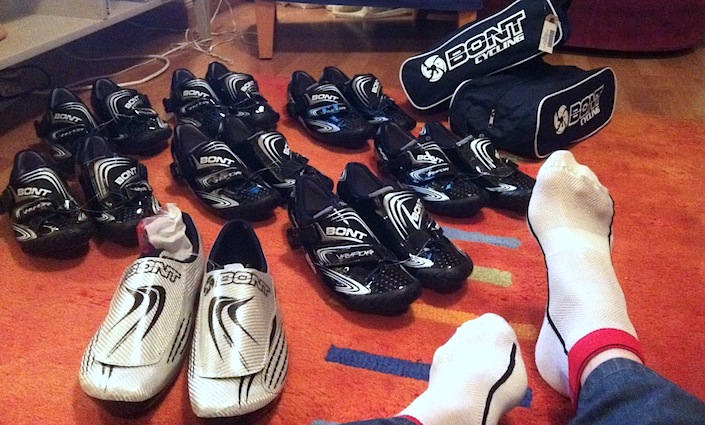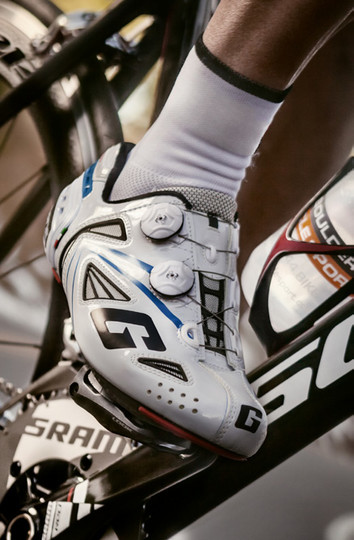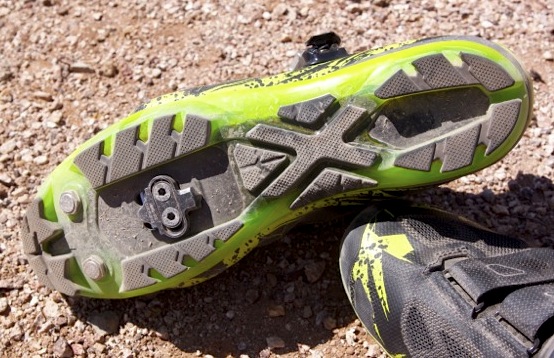When new to cycling, one of the most daunting prospects is "clipping-in" to your pedals. Everyone tells you it's the only way to ride, and you believe them, but it just seems such an odd thing to do....not to mention bloody dangerous!
GET CAUGHT UP: Clipping In
Ironically, that which seems dangerous is actually the safest action; this is true for clipping into a set of bike pedals. The only way is to get out and do it, but before you nick down to your local bike shop to check out the shoe range here are some simple guidelines to get you on the right track.
1. Fit
This is the reason it is important to go and see your local bike shop. Fitting is crucial with cycling shoes and can only be accomplished in person, with the shoe on your foot. Any knowledgeable bike shop staff will be able to help. Generally you want the shoe to be a slightly closer fit than you would generally wear when walking around, because you're not walking around....you're riding a bike!
To utilize your cycling shoes as intended a tighter fit ensures your foot cannot move around. In keeping your foot stationary in the shoe your ability to control the bike through the pedals and pedalling action is increased. There is nothing worse than your foot slipping around while trying to pedal up a hill, or when mountain biking, (where foot security is VERY important).

TIP: Many guys have wide feet! Fortunately there are brands which cater for this anatomical issue by making shoes with an extra wide last. This is also true for smaller women's feet. Ask your local shop for men's and women's options.
2. Closure
There are typically three different types of enclosure on the upper: Velcro straps, a ratchet buckle or a cable system such as BOA. We have created a comparison of four different road shoes.
Generally cheaper shoes will feature three velcro straps which is perfect for the beginner or even intermediate rider and allows for some degree of adjustment over different areas of your foot.
The next level up utilizes a ratchet buckle and usually two velcro straps. This setup is the most common at the mid-high level shoe and is my favorite. The easily adjusted ratchet is attached to a large strap which is brilliant at securing your foot in the shoe and is very comfortable as well.
The third type is the BOA system, which is found on many of the top-end models. This system uses a cable which runs continuously the length of the shoe and is usually tightened by a wheel at the heel or elsewhere on the upper. This type of closure mechanism fits the upper snug to your foot in all the right places offering supreme comfort and security.
The fourth option: Some brands offer custom fitted uppers for a reasonable price. This could be an option if you have trouble getting shoes to fit comfortably. There are also companies that offer custom shoe molding in materials like carbon fiber for the truly cashed up cyclist. This is not necessary for the casual cyclist but if you've got a bulging wallet, ask your local bike shop about these options.
3. Sole
This is where road and mountain bike shoes diverge. Road shoe soles are made from an inflexible nylon or carbon fiber depending on price. The purpose here is maximum stiffness and no flex at all, which translates into an efficient pedal stroke with no loss of power. This also makes road shoes notoriously difficult, and even dangerous, to walk around in.
Mountain bike soles are also stiff, but may offer a small amount of give, particularly in standard trail riding shoes, as you may need to dismount and walk over obstacles, dirt, rock etc. Some shoes also have screw in studs to help with muddy or steep walking sections.
On higher level mountain bike racing shoes you will find that the same stiff carbon sole as on a road shoe is normal, although there will be a raised nylon tread pattern on either side of the cleat position for extra grip and security when off the bike.

ADVICE: Cycle shoe shopping isn't about the cheapest price, especially when you're new to the game. The benefit of buying at your local bike shop is not only correct fitting, but they will also sort out attaching your cleats for you and may offer a quick fit to make sure all is positioned correctly (ask nicely!). One of the cheekiest actions in our online shopping world is trying a pair on at the local shop and then nipping home to buy online. Bad form mate!
4. Upper
Think light, minimal, comfortable and soft on a road bike. Roadies will often keep their shoes clean (well I do anyway, but they are Italian....and white...what choice do I have?) and match them with their kit!
Mountain bike uppers are going to be more robust and covered in dirt, dust and mud and probably have a slight musty smell from not having dried properly after a wet ride (personal experience!). Scuff proof materials at the toe and heel are normal and help to make the shoes last.
5. Cleats
Speedplay cleats
Cycling shoes will take any type of cleat generally, and it is the cleat which matches to the pedal. There are a couple of exceptions. First being the Speedplay pedal which uses a unique engagement system. Check that your new shoes are compatible at your local bike shop when purchasing.
Secondly, some mountain bike shoe treads can get in the way of certain pedal/cleat interfaces. If it's not picked up on at the time of purchase it may be a problem, particularly when using large bodied pedals. Hopefully all that is required is some filing down of the tread to get a good cleat engagement.
With this information you are now ready to visit your local bike shop and try on some shoes. Happy pedalling!





